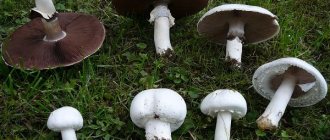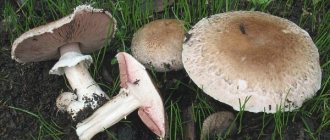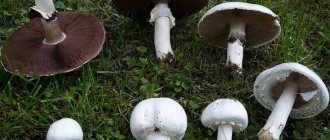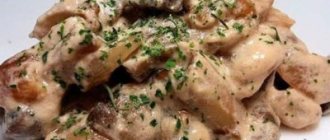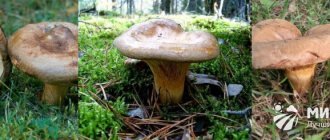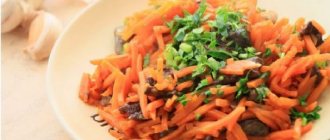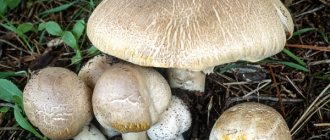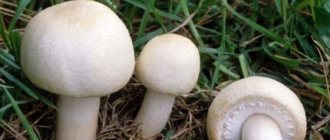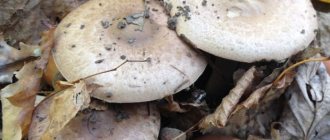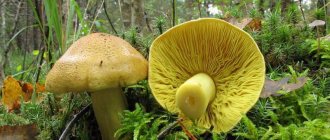Forest champignons are amazingly tasty and aromatic mushrooms, perfect for soups, stuffing, frying, pizzas, pies, pastes and sauces. Dishes containing them are low in calories and almost completely harmless, which is why they are so popular, especially among people who care about their figure and health. At the same time, it is not difficult to cook from champignons, and they are easier to process than other mushrooms, and therefore this product is actively used by both novice housewives and experienced chefs. We will tell you how to simply and deliciously cook forest champignons.
Description
Field champignons, unlike their relatives, are considered large mushrooms. Their caps reach up to 20 cm in diameter, there are smaller specimens - from 5 cm. The sizes depend on the growing conditions. What it looks like:
It is not difficult to recognize a mushroom if you know its characteristic features. The shape of the cap changes over time:
- at the beginning of the growing season - round, bell-shaped with edges turned inward and a completely hidden hymenophore;
- in middle age it is half-opened;
- at the adult stage, it acquires a prostrate-convex state with a tubercle in the center (the edges are wavy or smooth).
The color of the cap is initially whitish-cream. Then it becomes ocher, since the surface contains tiny scales with a brown or brown tint.
Other distinctive features:
- Ring. When fully ripe it hangs down. It has a two-layer structure - the upper ring is longer than the lower one. There are often jagged edges or waves along the edges.
- Pulp. At first it is very compacted, but over time it loses its elasticity and softens. Color: white. But, if you break the mushroom or press on it, after 5–10 minutes the flesh turns yellow (this is a reaction to oxygen).
- Records. Planted frequently. They are distinguished by slight swelling. Width - from 8 to 12 mm. At a young age - white with a gray tint, then light pink, mustard, brown and even black.
- Leg. Its length ranges from 6 to 10 cm, its shape is cylindrical. There is a thickening at the base. A coating of flakes can be seen on it. Like the cap, the stem turns yellow when subjected to mechanical stress.
The taste of field champignon is sweet. Mushroom aroma with notes of almond or anise (more pronounced in young mushrooms).
Champignon puree soup
A fairly simple first dish with a light consistency and unobtrusive taste. A great option for every day. Best served with small homemade white bread croutons.
Number of servings: 11
Cooking time: 1 hour
Energy value
- calorie content – 142.8 kcal;
- proteins – 7.7 g;
- fats – 9 g;
- carbohydrates – 7.8 g.
Ingredients
- chicken meat (boneless) – 250 g;
- potatoes – 350 g;
- champignons – 400 g;
- cream 20% – 250 ml;
- carrots – 80 g;
- onion – 90 g;
- spices - to taste;
- vegetable oil – 3 tbsp.
Step-by-step preparation
- Prepare one and a half liters of chicken broth. Boil the meat until it becomes soft. Add some spices to the pan until the liquid is no longer tasteless.
- Remove the meat from the dish and add the potatoes.
- Heat just a little oil in a frying pan and prepare a fry with mushrooms and vegetables. Then transfer to the potatoes. Cook until the ingredients are completely softened. Add chicken pieces and puree everything with a blender.
- Place the cream soup on the stove, heat it and pour in the cream in a thin stream. Turn off the burner and serve, topped with croutons.
Spreading
The field champignon adapts to all climatic conditions. It is found in all regions of Russia. Unlike other species, it does not like to be near trees, but there is an exception - spruce or pine.
Favorite localization locations (they are easiest to find):
- forest glades and meadows, that is, places with a large concentration of herbal plants;
- roadsides;
- areas with cleared forest;
- parks, alleys and gardens;
- pastures;
- near the nettle thickets.
The mushroom grows in different ways - alone, in groups, with the formation of ruts or arcs.
Culinary secrets
In order for a champignon dinner to be tasty and healthy, the cook needs to take several nuances into account.
- Fresh champignons can be replaced with frozen ones. If they are already cut, there is no need to even defrost them before cooking. When there is still a need to defrost mushrooms, it is better to transfer them from the freezer to the main chamber of the refrigerator in advance, since when defrosted in the microwave, the fruiting bodies become less tasty.
- Young champignons are more tender, tastier and look more appetizing. Large mushrooms are more aromatic, and only such ones are suitable for baking with filling. If you have the opportunity to choose mushrooms, consider which ones are most suitable for a particular dish.
- Store-bought champignons just need to be washed and blotted with a napkin before cooking. It is advisable to remove wild mushrooms, especially large ones, from the films covering the caps.
- Champignons for dinner can be fried, baked, or stewed. This process does not take much time, so it is not advisable to use a multicooker, but you can also cook mushrooms in it.
The best side dish for champignons is a vegetable one. They also go perfectly with pasta. You can also supplement the mushroom appetizer with buckwheat porridge or rice, or dishes from other cereals.
Please note: many champignon dishes do not require a side dish.
Collection period and rules
The harvest season for field champignons is long - from May to November. The exact time depends on the climate (the warmer, the earlier). Experienced mushroom pickers prefer to collect mushrooms that are fully ripe, but not overripe.
It is easy to determine the optimal stage of growth: the blanket film is not yet fully opened, but is stretched to its maximum. The diameter of the cap is about 10 cm. In this state, field champignons have:
- strong aroma;
- pronounced taste;
- fleshy pulp.
How to assemble correctly:
- do not pick or pick up wilted/damaged mushrooms;
- do not roughly pull them out of the soil, otherwise the mycelium will die;
- cut with a sharp knife (it is optimal to unscrew it while holding it by the leg);
- fill the holes with earth, which will help the new crop grow faster;
- Place the collected specimens with their caps facing up (preferably in a wicker container (basket, basket)), which will allow air to penetrate between the mushrooms.
Similar species
The field champignon has many varieties. Some of them are edible. “Relatives” are similar in many ways, but have different sizes, colors, etc. It is important to know about them, since there are also poisonous relatives.
Edible
There are many champignons that have a growing habitat identical to the field one, but the following species are most often found in Russia:
- Lugovoy. In appearance it does not differ from the field one. They recognize the double when it is broken - the flesh turns pink and then turns red.
- Crooked. The color of the cap is cream, the flesh is white. The size is almost 2 times smaller than that of its field relative. The main difference is that when pressed, spots of a very bright yellow hue are formed.
- Pereleskovy. The size of the cap is 2 times smaller, but the length of the stem is identical to its field brother. The pulp is thin and becomes ocher when cut. The smell is anise. Based on this feature, mushrooms are often confused.
- False value. Yellow-pink hat. The center of the dome is dark, the edges are light. The leg has white small scales on the surface. The smell of the mushroom is reminiscent of horseradish or radish.
Poisonous
Toxic twins in Russia are found in only two varieties. Poisonous and edible mushrooms are the same in shape and place of growth. Dangerous representatives of eukaryotes differ from field champignons in the following characteristics:
- Death cap. A very poisonous specimen. In appearance it resembles a champignon, but is distinguished by a swelling at the base of the stem, covered with the remains of a blanket. The ring is single-layer, located closer to the bottom. There is no anise or nut aroma. The plates are exclusively white. At the beginning of development, plants are confused.
- Red-haired. It differs from the field one in the color of the cap. It is yellowish, red or pink. On the leg (in the lower part) there is a brown swelling like a sac. When the fruiting body is broken, the pulp turns yellow at lightning speed. The peculiarity is the unpleasant smell of a pharmacy (carbolic acid).
Many new mushroom pickers collect all the mushrooms they come across in a basket. They are already sorting through the finds at home. This is fundamentally wrong. Picked toadstools release toxins from the cuts that can poison edible champignons.
Interesting facts about pecheritsa mushrooms
There are many interesting details in the history of pecheritsa:
- these are the first mushrooms that began to be grown in an unnatural environment for them;
- The unique properties of champignons are widely used in cosmetology: they are included in masks and lotions;
- Eating pecheritsa relieves fatigue well;
- arginine and lysine contained in the fruit body stimulates human mental activity;
- In terms of the amount of phosphorus, pecheritsa are superior even to seafood.
Nutritional quality and value
Field champignon is considered a dietary product. Its calorie content per 100 g is only 27 kcal. Nutritionists especially note its nutritional value:
- 4.3 g protein;
- 2.6 g dietary fiber;
- 1 g fat;
- 0.1 g carbohydrates;
- 91 g water.
The composition does not go unnoticed:
- vitamins B, A, E, C, PP, beta-carotene;
- microelements - iodine, chromium, cobalt, zinc, iron, fluorine, rubidium, molybdenum;
- macroelements - magnesium, calcium, potassium, chlorine, phosphorus, sodium;
- fatty acid.
Mushroom champignon soup recipe
When all the usual first courses get boring, every housewife begins to look for new recipes. A great way to diversify your daily menu is to prepare a hearty mushroom soup.
Number of servings: 11
Cooking time: 1 hour 10 minutes
Energy value
- calorie content – 106.5 kcal;
- proteins – 10 g;
- fats – 6.7 g;
- carbohydrates – 1.5 g.
Ingredients
- chicken – 250 g;
- potatoes – 300 g;
- onion – 1 pc.;
- carrots – 1 pc.;
- processed cheese – 150 g;
- champignons – 400 g;
- vegetable oil – 35 ml;
- bay leaf – 2 pcs.;
- pepper – 3 peas;
- salt - to taste.
Step-by-step preparation
- Rinse the chicken, place in a saucepan and pour in about 1.8 liters of water (cold). Place on the burner, turn on maximum power and bring to a boil. During the process, gray foam will begin to actively appear, which should be disposed of. Then cover partially with the lid. Reduce gas and boil the bird for 35 to 45 minutes.
- At this time, use a housekeeper to peel the potatoes, onions, carrots and mushrooms. Slice. You don’t have to go too small with the champignons. Considering that their taste is not too strong, it is better if they are cut larger. A Korean-style salad attachment is suitable for chopping carrots.
- Remove the meat from the broth and cut into cubes. It is worth considering that the amount of “net” weight is indicated. If you use chicken legs or any other part of the bird, be aware of the bones. Pass the liquid itself through a sieve.
- Add the tubers into the broth in the form of medium cubes. Boil for 10 minutes and start frying.
- First, sauté the vegetables, then add the mushrooms. Place in a common bowl. Cook until the ingredients soften, adding salt and spices.
- At the end, add grated cheese in moderate portions. Let it brew a little.
Tip: if you use canned champignons, the cooking technology does not change. The only thing is, try to completely get rid of the brine, and add a little mushroom seasoning to the soup itself to enhance the taste.
Medicinal properties
Due to their rich composition, field champignons have a healing effect. They are used to make drugs. Recommended for use for the following diseases:
- diabetes;
- obesity;
- headache;
- problems with the kidneys, cardiovascular and nervous systems;
- tuberculosis;
- anemia;
- typhus;
- skin diseases;
- allergy;
- bronchitis.
Main properties of champignons:
- appetite suppression;
- acceleration of metabolism;
- improvement of visual acuity;
- normalization of unstable psyche;
- removal of cholesterol from the body;
- regeneration of damaged tissues;
- neutralization of bacteria and viruses;
- activation of the brain.
A special extract is isolated from mushrooms. It has a beneficial effect on hair growth, strengthening hair follicles and nail plates, improving the condition of the skin of the face and body. Lotions, balms, creams, serums, etc. are made from the extract. The cost of such products is high.
Beneficial properties of meadow champignons
Regular consumption of summer meadow champignons has a very beneficial effect on the health of the entire body. These mushrooms contain a lot of useful substances necessary for humans, such as:
- amino acids (there are 18 of them in total);
- vitamins (B1, B2, B9, B12, C, E, D, PP);
- organic acids (folic, oxalic);
- minerals and trace elements (iron, phosphorus, calcium, magnesium, potassium, iodine, selenium).
In addition, the pulp of meadow champignons contains lecithin, which has a positive effect on the functioning of the nervous and cardiovascular systems.
Meadow champignons contain vitamins, amino acids and microelements
Use in folk medicine
The beneficial properties of champignons have long been used in folk medicine to treat diseases such as influenza, bronchitis, tracheitis and bronchial asthma. The pulp of the fruiting body of meadow champignons has antiviral, expectorant and anti-inflammatory properties.
An extract from these mushrooms successfully treats purulent skin diseases, ulcers, and psoriasis, since it has a disinfecting effect. In addition, the antioxidants contained in meadow champignons have a rejuvenating effect on the body.
Restrictions and contraindications
Champignons are considered the safest mushrooms and have no contraindications (except for individual intolerance). However, you should not abuse them, since they contain chitin, which is poorly absorbed by the body. Therefore, it is recommended to heat treat meadow champignons before eating them.
It is not advisable for children under 12 years of age to introduce mushrooms into their diet, since they are heavy foods. Also, people with gastrointestinal diseases should eat champignons with caution.
Harmful indicators of the fungus
Based on taxonomy, over a long growing season the mushroom accumulates heavy metals (copper, cadmium) and other toxins, that is, substances potentially dangerous to the human body. For this reason, it is not recommended to collect old champignons.
Specimens found on the territory of large production plants, near roadsides and garbage dumps are also harmful. Overeating worsens chronic diseases, especially gastritis and ulcers.
Contraindications:
- children's age - up to 5 years;
- problems with the digestive system;
- individual intolerance to mushrooms.
Champignons stewed in cream in a saucepan or frying pan
What do you need:
- champignons – 0.3 kg;
- butter – 30 g;
- cream – 80 ml;
- hard cheese – 60 g;
- chicken egg – 1 pc.;
- salt, ground black pepper, nutmeg - a pinch.
How to cook:
- Cut the champignons into slices, place them in a saucepan with melted butter and fry until excess liquid evaporates.
- Whip the cream with the egg, salt and seasonings, pour it over the mushrooms, sprinkle with grated cheese.
- Cover the saucepan with a lid. Simmer the appetizer over low heat until the sauce thickens.
You will like champignons in cream much more if you replace the whole egg with two egg yolks.
Storage methods
Field champignons are stored in different ways: frozen, dried, canned. They are pickled, fermented and salted, but the main requirement is the need for cooking. If the fruits are collected in ecologically clean regions, it is permissible to use them fresh.
Freezing
Champignons can be frozen boiled or raw. In the first case, they are considered ready to eat, in the second, after defrosting they will have to undergo heat treatment (cook/fry). The shelf life during such storage ranges from 12 to 18 months.
Peculiarities:
- packaging - plastic container, vacuum bag, regular bag;
- the rule is that you cannot freeze it twice, that is, after defrosting, you should immediately use the product;
- storage form - cutting into slices, cubes, whole;
- mandatory pre-treatment - after cooking or washing, a drying procedure is carried out on a towel;
- An acceptable measure is that it is not necessary to wash the mushrooms before freezing; just wipe with a soft cloth and brush (to remove dirt).
Pickling
Pickled mushrooms were considered the best dish in Rus', so the preparation method is still used today. The taste of champignons will be specific, but pleasant.
Ingredients:
- mushrooms - 1 kg;
- salt - 75–80 g;
- sugar - 30 g.
Recipe:
- Boil the champignons for 10 minutes. Drain in a colander.
- Place in a saucepan, basin, etc., add sugar and salt, mix thoroughly.
- Place a weight on top.
- Inspect the container after a day - juice should form. If there is none, add a little water so that all the mushrooms are covered with liquid.
Keep the basin at a temperature not lower than + 20°C, fermentation time - 7-10 days (optimally - 25-30). After a week, transfer the product to jars and transfer it to a cellar, basement, or other cool place. It cannot be stored for a long time. Need to use within 2 weeks.
It is strictly forbidden for people with high stomach acidity to eat pickled champignons.
Pickling
Marinated champignons are used as a snack. There are many recipes, but there is a universal and quick one. You will need the following components for 1 kg of mushrooms:
- water - 250 ml;
- salt and sugar - 1 tbsp. l.;
- vinegar (9%) - 5 tbsp. l.;
- garlic - 7–9 cloves;
- black peppercorns - 15–20 pcs.;
- bay leaf - 2–3 pcs.;
- vegetable oil - 2 tbsp. l.
Recipe:
- Place all ingredients in a saucepan.
- Put it on fire.
- After boiling, boil for 7–9 minutes.
- Place the mushrooms in sterilized glass jars, roll up, cool and refrigerate.
- Use within 12 months.
Drying
Dried champignons are used to prepare various dishes. From the ingredient crushed to powder form, delicious puree soup and sauce are obtained.
There is no need to wash mushrooms before drying. This will increase drying time. If the fruits are large, they are cut into slices and cubes.
Drying methods:
- In the oven. Arrange the mushrooms in a single layer on a baking sheet. Bring the oven to + 50°C. Keep for 6–7 hours. Then increase the temperature by 30°. Dry for another 19–20 hours. Follow the basic requirement - open the oven door slightly.
- In an electric dryer. The fastest way. Proceed according to the instructions for the specific device.
- On a thread. This is a long, natural process. Thread small mushrooms onto a thread whole, chop large ones. Hang in a dry, ventilated area. To protect the product from insects, cover with gauze. Champignons dry from 7 to 15 days, depending on weather conditions and size.
Shelf life is 6 months. It is customary to store dry mushrooms in bags made of natural fabric or glass jars.
Pickling
Salted champignons are used for preparing salads and as an independent dish for side dishes. You will need:
- mushrooms - 1 kg;
- salt - 5 tbsp. l.;
- sugar - 1–2 tsp;
- garlic - 8-10 cloves;
- dill umbrellas - 80–100 g.
What to do:
- Boil the mushrooms.
- Place all the ingredients randomly in one container.
- Fill with water until it covers all components.
- Cover with a lid or plate, lay down the oppression.
- Keep at room temperature for 24–30 hours.
- Transfer to the refrigerator for 7 days.
- Place in jars and fill with the resulting brine.
- For winter use, sterilize the container before placing in jars. Then roll it up. Store in the refrigerator: 2 weeks without sterilization, within a year - in treated containers.
If the mushrooms are too salty, soak them in plain water before cooking or serving.
Canning
This method provides for long-term storage - up to 6-7 months. Be sure to sterilize glass jars and sealing lids before sealing. For 1 kg of champignons, take the following:
- salt - 1 tsp;
- sugar - 1 tbsp. l. without slide;
- water - 250 ml;
- citric acid - on the tip of a knife;
- cloves, white and allspice - 7 pcs.;
- other spices - optional, optimally add thyme and rosemary (0.5 tsp each).
Preservation process:
- Mix water, mushrooms, salt.
- Boil until done.
- Strain. Set the mushrooms aside and place the liquid on the fire, adding all the other ingredients.
- Boil the brine for 5–10 minutes.
- Place the mushrooms in jars and pour boiling marinade over them.
- Roll up the lids and place upside down under the blanket.
How to cook fresh and frozen champignons in a saucepan?
During heat treatment, mushrooms tend to change their color to a darker one. To prevent them from darkening during cooking, add 1 g of citric acid to boiling water.
How to boil champignons for salad?
Boil water in a saucepan, add salt, season with pepper (peas) and bay leaf. Cook the champignons in boiling water for 7 minutes. Then drain in a colander and cool.
Once frozen, the product is thawed and then immersed in boiling water. Boil for 10 minutes, after which the water is drained and used for various dishes.
How to cook champignons for mushroom soup?
Champignons for soup are pre-sorted, peeled and washed in cool water. Then cut into the required pieces and put into boiling salted water, cook over medium heat for about 5 minutes, then drain in a colander and use for soup.
The frozen product is thawed, after which the champignons should be prepared in the same way as fresh mushrooms.
How to process field champignon?
Before storing, if drying is not provided, field champignons are processed. What should be done:
- wipe off dirt from all sides with a rag and brush;
- cut off the ends of the legs and all damaged areas;
- rinse under running water, but do not leave the mushrooms in the water (they will absorb moisture and become watery);
- spread on a paper towel in a single layer to dry.
If the mushroom is not very young, experts recommend removing the film.
Champignons stuffed in the oven
There are many variations of fillings for the dish - ham and cheese, chicken, and vegetables with rice. In general, there are as many flavors as there are so many ways to make this festive dish. We suggest preparing mushroom “molds” with minced meat. Such a dish can be regarded both as an independent dish and as an appetizer - after all, even chilled champignons are very tasty.
Number of servings: 4
Cooking time: 40 minutes
Energy value
- calorie content – 381.9 kcal;
- proteins – 22.7 g;
- fats – 31.3 g;
- carbohydrates – 2.4 g.
Ingredients
- minced meat - 300 g;
- champignons - 500 g;
- cheese (any hard) - 100 g;
- onion - 1 pc.;
- spices - to taste;
- salt - to taste;
- olive oil - 50 ml.
Step-by-step preparation
- Prepare the champignons. In this case, preference should be given to fairly large specimens. Carefully separate the leg to the very “root”, and then cut it into small fragments. Salt the caps - while you prepare the filling, they will absorb the seasoning.
- In a bowl, mix the minced meat, spices and mushrooms, which you first fry in a small amount of olive oil and cool.
- Line a baking sheet with baking parchment and place the caps on it like baskets. Fill with minced meat and sprinkle cheese on top. Set the oven temperature to 170 degrees and cook the appetizer for about 35 minutes.
How to cook?
Field champignons are easy to heat treat. Their structure is delicate and does not require long cooking. Cooking methods and features:
- Cooking. After initial processing, cook in lightly salted water for no more than 10 minutes. Once ready, immediately drain in a colander to drain completely.
- Frying. Boiled and raw products are suitable for frying. In the first case, it is enough for the mushrooms to be on the fire for 5 minutes, in the second, process for up to 15 minutes. Note: the frying pan should be on high heat.
To improve the taste during frying, add chopped onions, ground black pepper and a little dill.
Stewed champignons with sour cream
This dish is suitable as an addition to lunch, or for dinner as a tasty and satisfying side dish.
Ingredients:
- fresh champignons – 500 gr.;
- bulbs – 2 pcs.;
- garlic – 2-3 cloves;
- vegetable oil;
- fat sour cream – 200-250 g;
- oil drain – 20 gr.;
- pepper, salt, herbs and other seasonings to taste.
Cooking method:
- Cut the mushrooms into small pieces. Heat a frying pan, pour in vegetable oil, and add mushrooms.
https://www.youtube.com/watch?v=KCd_-OK8ACw&feature=youtu.be - Pour oil into the second frying pan and add pre-chopped and peeled onions. The ingredients are fried separately, stirring occasionally.
- While the onions and mushrooms are frying, finely chop the greens. It must be added at the end. Also finely chop or grate the garlic.
- Once the mushrooms and onions are ready, combine them together. Add a piece of butter there and mix. Leave covered for 3-5 minutes.
- Then add salt, pepper, garlic and stir. Pour in sour cream and stir well again.
- Add dill at the end of cooking. Leave it covered for 2-3 minutes and turn off the heat.
If the sour cream is low in fat (less than 20%), then to prevent it from curdling, you can first add a small amount of flour.
Is it possible to grow such a champignon?
Field champignon quickly adapts to all conditions: it is grown in personal plots, in the basement, in bags, boxes, jars, etc. The main thing is to collect spores.
For this:
- Find a mushroom in the forest.
- Pinch off pieces from it.
- Place them in a nutrient medium (make a mixture of 3.5 tbsp agar-agar, 1.5 tbsp oatmeal and 1 liter of water).
The mycelium will produce white threads in 10–12 days, after which it is transplanted to a permanent place.
How to plant in the garden:
- Sprinkle rotted manure or compost over the soil.
- Spread the mycelium. At the same time, do not uproot the vegetation or tear off the grass.
When growing in the basement, the basis is a similar sequence of actions, that is, placing the mycelium on the soil. Just adhere to the following conditions:
- air humidity - 85–90%;
- temperature - during germination + 15°C, after germination - + 20°C.
The first full harvest is obtained in 2–2.5 months.
Field champignon is a valuable product. It has excellent taste and medicinal properties. It is collected from the wild and grown at home. The main thing is not to make a mistake with the species representative. A careful study of the indicators of appearance and edibility will help you learn to distinguish field champignons from their poisonous relatives.
0
0
Copy link
Growing at home and in the country
The most common mushrooms have long been grown in greenhouses, basements and garden beds.
It is very important for them to prepare high-quality compost:
- Take 6 kg of straw and 4 kg of manure.
- Place everything layer by layer in the prepared hole.
- Water every day and turn with a pitchfork once a week.
- After three weeks the compost is ready.
The time may vary depending on the raw materials and air temperature, but as soon as the ammonia smell disappears, the mixture can be used. Compost is spread on the beds.
It is better to purchase the mycelium itself from a responsible seller.
When growing outdoors, you should choose the most shaded area:
- The soil is slightly fluffed up.
- Plants, grass, roots should be left, they will help the mycelium form.
- The surface is sprinkled with mycelium and covered with prepared compost.
- You need to water as needed.
The first harvest, as a rule, germinates after 2.5 months. Sowing can be done in spring, summer or autumn. In winter, the mycelium is covered with fallen leaves and pine needles.
